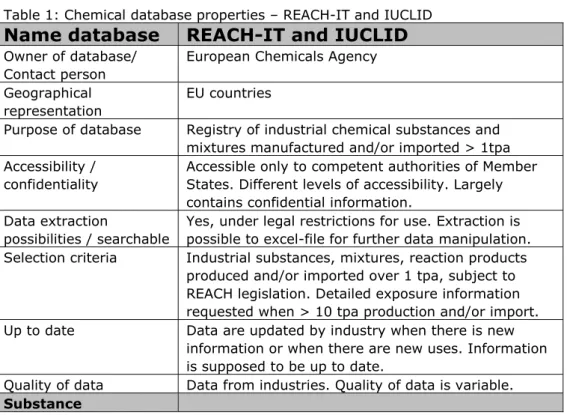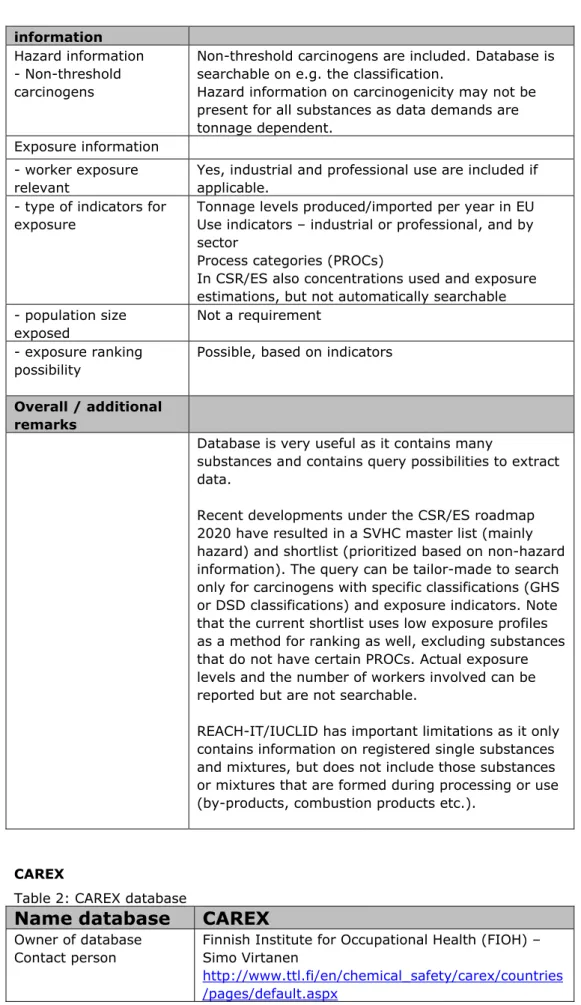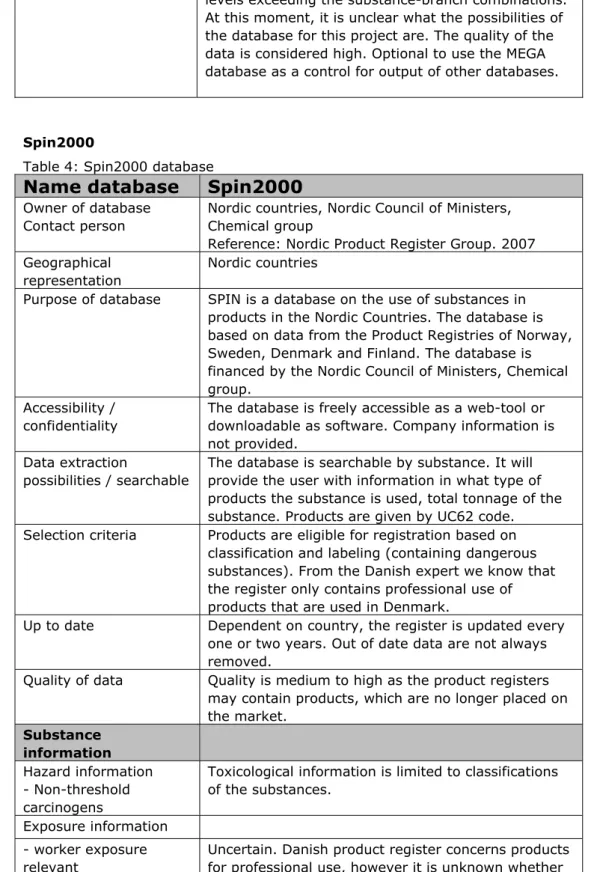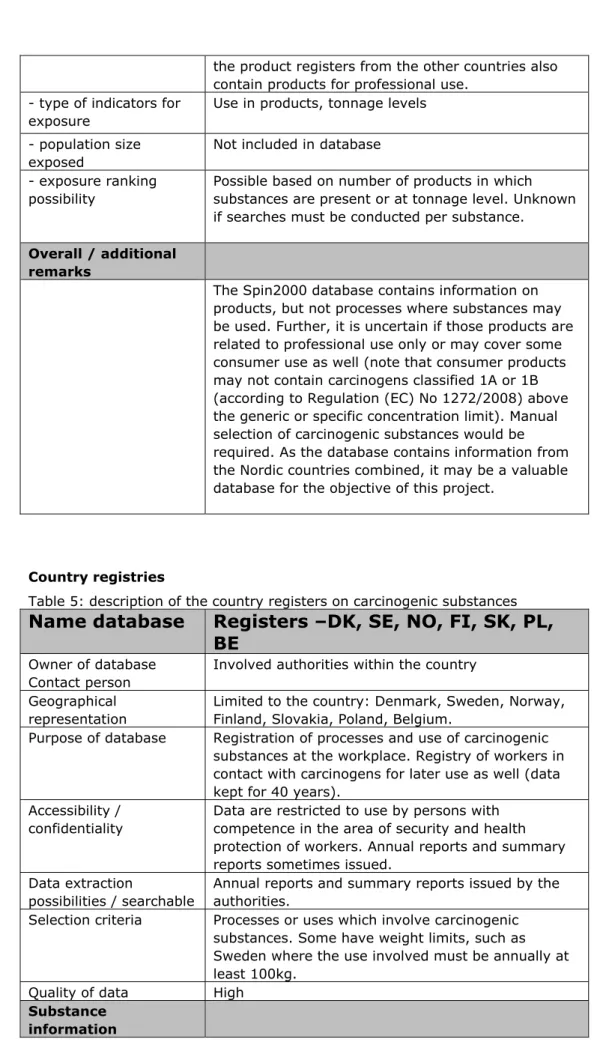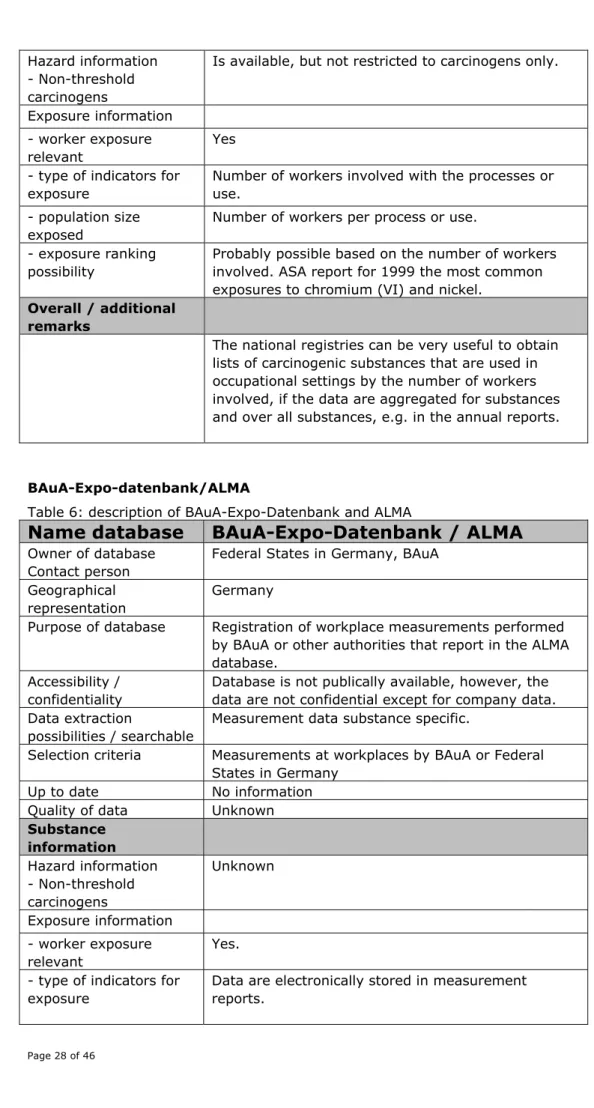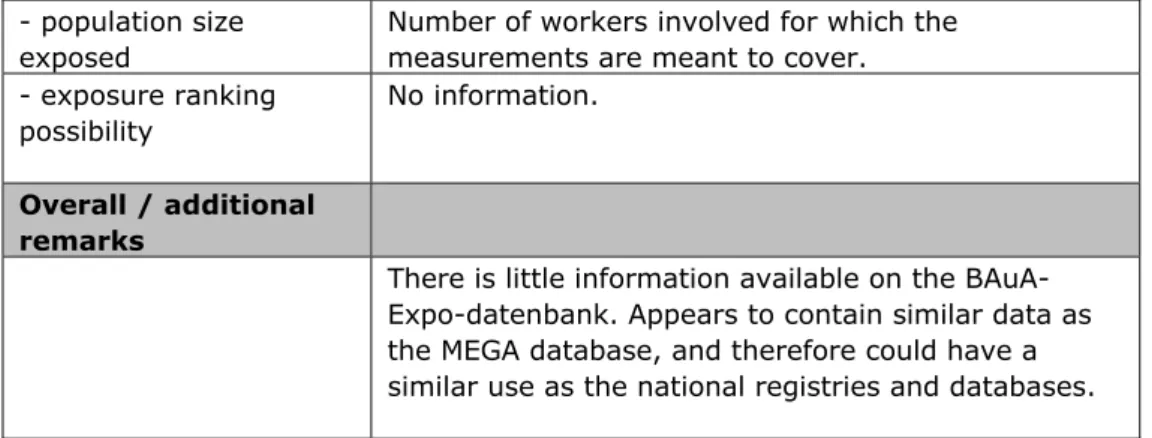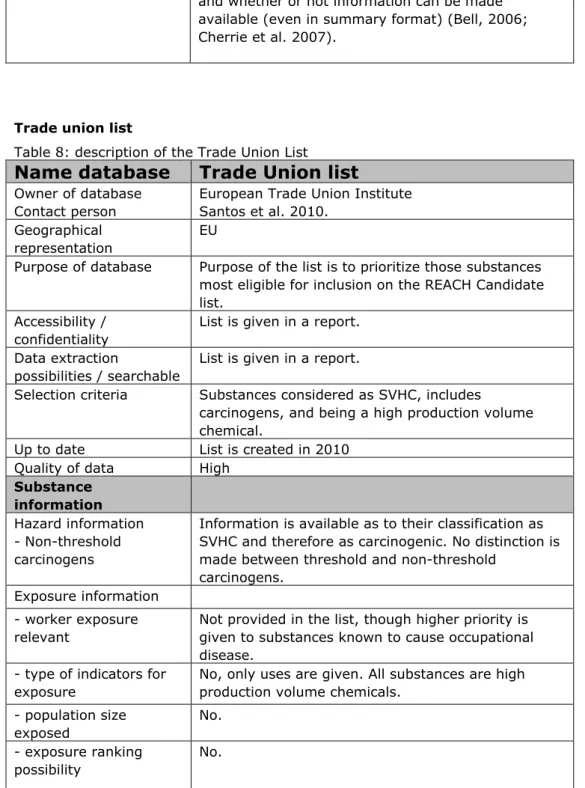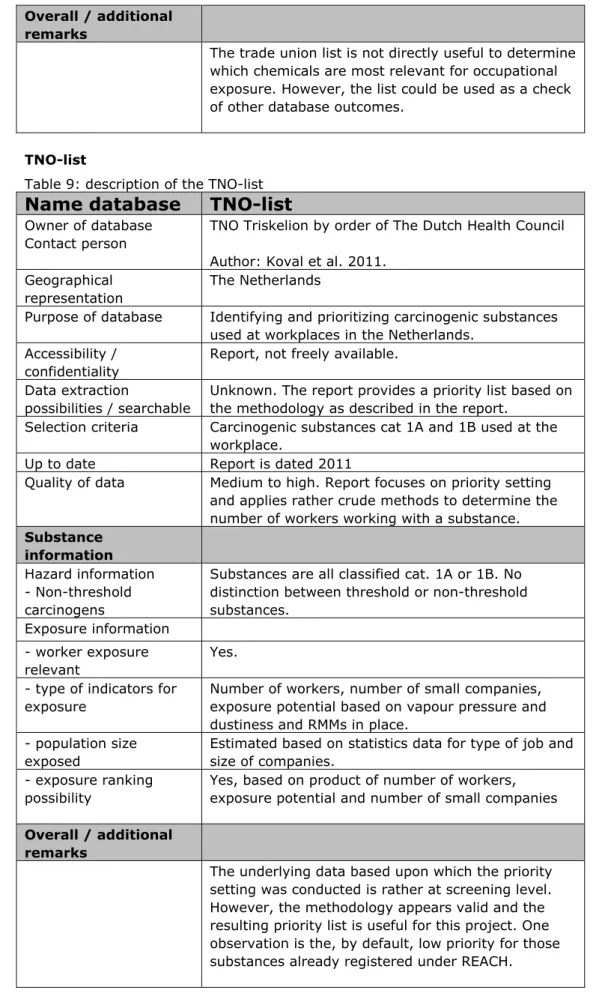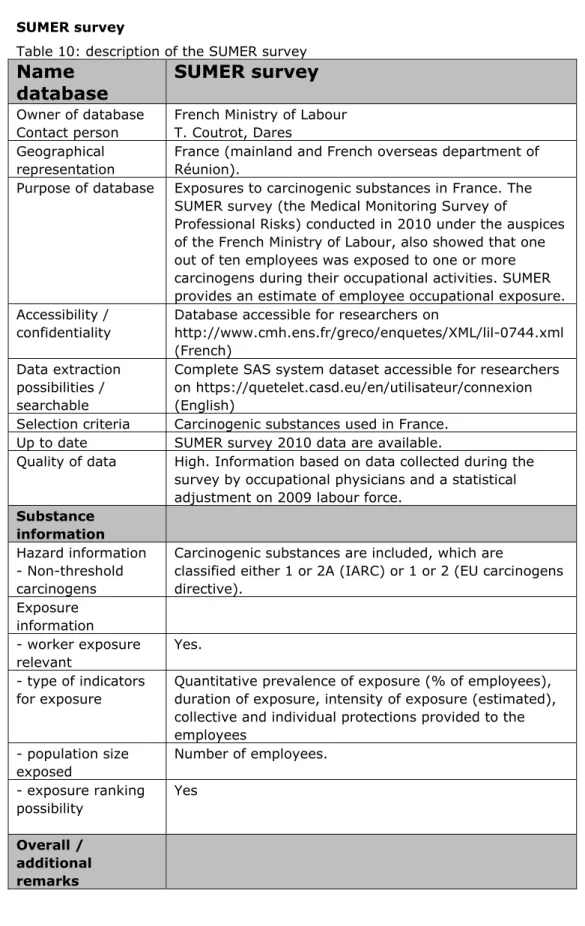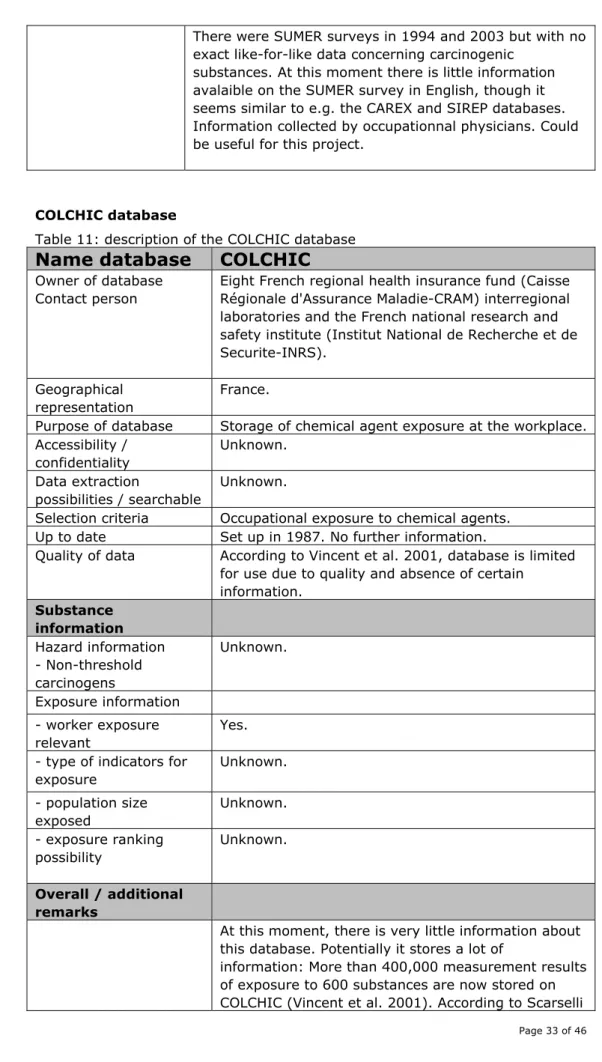Inventory of databases containing
worker exposure data on non-threshold
carcinogens in Europe
RIVM Letter report 2014-0083 W. ter Burg
Colophon
© RIVM 2014
Parts of this publication may be reproduced, provided acknowledgement is given to: National Institute for Public Health and the Environment, along with the title and year of publication.
W. ter Burg
(RIVM-VSP)
Contact:
Wouter ter Burg
Centre for Safety of Substances and Products Wouter.ter.Burg@rivm.nl
This investigation has been performed by order and for the account of the Ministry of Social Affairs and Employment, within the framework of SZW helpdesk
This is a publication of:
National Institute for Public Health and the Environment
P.O. Box 1│3720 BA Bilthoven The Netherlands
Publiekssamenvatting
Inventarisatie van databases met informatie over blootstelling van werknemers aan kankerverwekkende stoffen in Europa
Het ministerie van SZW wil inzicht krijgen in welke mate werknemers in Europa blootstaan aan kankerverwekkende stoffen. Om de meest voorkomende
kankerverwekkende stoffen te kunnen identificeren, heeft het RIVM geïnventariseerd welke databases en andere bronnen informatie daarover bevatten. Op basis hiervan wordt een lijst van stoffen opgesteld die Europees als eerste aangepakt zouden moeten worden om de veiligheid van werknemers te vergroten.
Het gaat om kankerverwekkende stoffen of processen zonder drempelwaarde. Dit zijn stoffen die altijd een risico met zich meebrengen als mensen eraan blootgesteld worden. Europese wetgeving schrijft voor om dergelijke stoffen waar mogelijk te vervangen. Indien dit niet kan, dient de werkgever de
mogelijke blootstellingen en risico’s zo laag mogelijk te houden. Op dit moment, verschilt de aanpak van kankerverwekkende stoffen per lidstaat.
De identificatie van twaalf databases en andere bronnen is tot stand gekomen op basis van input die experts uit elf EU-lidstaten hebben aangereikt. Op basis van de inventarisatie blijkt dat de REACH-IT/IUCLID-database, in combinatie met de nationale registers en databases, zoals de MEGA-database, SUMER-survey en de SIREP-database, het meest geschikt zijn om de meest voorkomende kankerverwekkende stoffen te identificeren. Deze databases bevatten namelijk de benodigde informatie over de hoogte van de blootstelling en het aantal werknemers dat aan deze stoffen blootstaat. Ook wordt
aanbevolen om de doorontwikkelingen van de, op dit moment gedateerde, CAREX-database te volgen. Deze database bevat de benodigde informatie over het aantal werknemers dat blootstaat aan kankerverwekkende stoffen voor een groot aantal EU-lidstaten.
Abstract
Inventory of databases containing worker exposure data on non-threshold carcinogens in Europe
The Ministry of Social Affairs and Employment requested the RIVM to provide an insight in occupational exposure to carcinogens at the workplace across Europe. To identify the most occurring carcinogens, an inventory was made of databases and other sources containing information on occupational exposure to
carcinogens. Based on this inventory, a list of most occurring carcinogens will be made. Those substances will be dealt with first on a European level to increase the safety of workers.
The report focuses specifically on non-threshold carcinogens. Non-threshold carcinogens are without a safe level of use. European worker legislation
prescribes that those substances should be replaced wherever possible. If this is not possible, employers must ensure that exposure is as low as reasonable achievable. At this moment, the approach to deal with carcinogens differs amongst Member States.
Twelve databases, lists and other sources containing worker exposure data on non-threshold carcinogens were identified, based on the consultation of
nominated experts from eleven European Union Member States. The databases and other sources were evaluated to determine which databases and other sources would be most suitable to identify non-threshold carcinogens workers are mostly exposed to in Europe. The REACH-IT/IUCLID database in combination with country registries and databases, such as the MEGA database, SUMER survey and SIREP database, are most suited because they contain the required information on the number of workers exposed and the level of exposure to carcinogens. Further, it is recommended to follow-up on recent activities by which the CAREX database will be updated. The CAREX database contains information on worker exposure to carcinogens from several EU Member States.
Contents
Contents ─ 7
Summary ─ 9
1
Introduction ─ 11
1.1
Background of the project ─ 11
1.2
Method ─ 11
2
Registration of carcinogens at the workplace in Europe ─ 13
2.1
Belgium ─ 13
2.2
Denmark ─ 13
2.3
Finland ─ 14
2.4
Germany ─ 15
2.5
Norway ─ 16
2.6
Poland ─ 16
2.7
Slovakia ─ 17
2.8
Spain ─ 18
2.9
Sweden ─ 18
2.10
The Netherlands ─ 19
2.11
United Kingdom ─ 19
3
Overview of databases, surveys and lists on carcinogens at the workplace ─ 21
3.1
REACH-IT/IUCLID ─ 21
3.2
CAREX ─ 22
3.3
MEGA database ─ 24
3.4
Spin2000 ─ 26
3.5
Country registries ─ 27
3.6
BAuA-Expo-datenbank/AL ─ 28
3.7
NEDB ─ 29
3.8
Trade union list ─ 30
3.9
TNO-list ─ 31
3.10
SUMER survey ─ 32
3.11
COLCHIC database ─ 33
3.12
SIREP ─ 34
4
Conclusion and recommendations ─ 37
4.1
Recommendations ─ 38
5
References ─ 41
Acknowledgments ─ 43
Summary
The chemical legislation related to worker safety aims, among others, to reduce the use of and exposure to carcinogenic substances. Across Europe, Member States have different ways to deal with carcinogenic substances. This report is a first step in the identification of those substances that are considered most prudent to deal with first from an exposure perspective. The ultimate aim is to derive a shortlist of carcinogenic substances that previously have been
identified, based on their exposure potential to the worker across Europe, which is the second phase of the project. The first phase is limited to setting up the methodology to obtain the shortlist. The aim of this report is to identify and describe the systems Member States have in place, to track the use of and exposure to those substances in their country and to identify substance databases that contain exposure-related information on carcinogens at the workplace. Based on the results, a proposal is made for an approach to generate the desired shortlist including suggestions for which underlying database(s) to use.
Nominated experts from several Member States were consulted by
questionnaire. Simultaneously, a literature search was conducted to find suitable sources on worker exposure to carcinogens. Based on the input of the
nominated experts, an overview of tracking systems in their countries is provided. In addition, an overview of databases and other sources is presented along with an evaluation of their usefulness.
Information from 11 countries in the EU showed that many countries where companies are obliged to provide information, keep registries of the use of carcinogenic substances at the workplace. The information in those registries is not publicly available, but annual reports on carcinogenic substances used are published in some countries. The questionnaire and literature search resulted in 12 databases or sources that are of interest. The REACH-IT/IUCLID database, CAREX, and Trade Union list are at EU level. The first two are concluded to be useful to obtain information on carcinogens at the workplace. Other databases are mostly at national level and are considered most useful as supportive evidence of use of substances at the workplace. Since the information in CAREX is at this moment outdated, it is recommended to use the REACH-IT/IUCLID database, supported by information from country registries and databases, such as the MEGA database, SUMER survey and SIREP database.
1
Introduction
1.1 Background of the project
The chemical legislation related to worker safety aims at reducing the use and exposure to carcinogenic substances, according to the Chemicals Agents Directive (CAD, 98/24/EC) and the Carcinogens and Mutagens Directive (CMD, 2004/37/EC). Across Europe, adhering to those Directives, there are different ways to deal with occupational use of and exposure to carcinogenic substances. Current discussions at Member State and EU Commission level concern the identification of those carcinogenic substances with the highest potential exposure at workplaces in Europe. This report focuses therefore on identification of information sources to identify those substances that should be considered first from a use and exposure perspective.
In this project, the focus lies specifically on non-threshold carcinogens. Substances with a threshold effect can be dealt with by applying limit values below which one would not expect adverse health effects, whereas for non-threshold substances no safe levels can be established. An adequate control of occupational exposure to those substances with the highest potential exposure could contribute to a significantly improvement of worker’s health. Therefore, a shortlist of the non-threshold carcinogens with the highest potential exposure is needed. Agreements on how the exposure to non-threshold carcinogens at the workplace can be controlled are important. One can think of means to derive exposure levels associated with negligible risks and strategies to reduce exposures to non-threshold carcinogens. Currently, at EU Member State level there is no widely agreed way how to set these exposure levels (Pronk, 2014). Though the terms ‘non-threshold carcinogen’ and ‘substance’ are used in this report, carcinogenic processes and formation products are not excluded from the scope of this project. A distinction between single substances and complex mixtures or processes is made specific where appropriate.
Aim of the project
The aim of this project is to identify tools to prioritize non-threshold carcinogens with use and exposure as one of the main criteria, in order to derive a shortlist of non-threshold carcinogenic substances that should be given first priority. The present report does not present a shortlist. It only focuses on the identification of the possible sources and tools. This is achieved by identifying the systems Member States keep in place, to track the use of and exposure to carcinogenic substances in their country, and to identify substance databases that contain exposure related information of carcinogens at the workplace. As precondition, the information must be accessible at the level superseding that of individual substances, to be able to prioritize substances. A proposal is made for an approach to prioritize non-threshold carcinogenic substances.
1.2 Method
The Dutch Ministry of Social Affairs and Employment (MinSZW) provided a list with contact information of experts of several Member States. The nominated experts were contacted after which a questionnaire was sent to them (see Appendix). Briefly, the questionnaire asked about information on tracking systems and databases in their country or if they were aware of other systems
abroad. Simultaneously, a literature search was conducted to find other suitable sources on worker exposure to carcinogens (such as surveys or lists). Based on the input of the nominated experts, an overview of systems is presented in chapter 2. In chapter 3, a description of a number of databases and additional sources is given along with an evaluation of their usefulness for the purpose of prioritization of non-threshold carcinogens. The databases where selected based on the availability of worker exposure data for a large number of substances. Considering the overviews described in chapters 2 and 3, a proposal for a prioritization approach is made. A draft report was sent to all nominated experts for consultation, after which the report was finalized.
2
Registration of carcinogens at the workplace in Europe
The way of registering the use of (carcinogenic) substances at the workplace in several EU Member States is described in this section. A short summary of each registration system is given based on the input from the respondents. The description focuses on the procedure, the infrastructure of the systems used and the type of information that is contained in the system. The systems are
described by country in alphabetical order. Next to the tracking systems, some respondents noted that certain institutes or organizations in their country track the use of and exposure to carcinogens in specific databases. These are
identified here and will be described in more detail in chapter 3.
2.1 Belgium
Belgium operates a system where “external services for prevention and
protection at work” (ESPPs) register the chemical exposure (not limited to (non-threshold) carcinogenic substances) at the workplace and send an annual report to the Federal Public Service Employment, Labour and Social Dialogue as required by law. A Belgian employer can apply to an ESPP if the employer’s “internal service for prevention and protection at work” cannot fulfil all the legally required tasks (which is most often the case). The ESPPs are collecting the data at the level of the individual company, but in the annual reports, the exposure data of all their clients are grouped. Specific information from annual reports can be requested.
The type of information contained in the registry is: name of the
substance/substance category, the number of exposed workers, the number of the exposed workers that have undergone a medical surveillance and the distribution of the results of the medical surveillance. Specific exposure estimates are not stored in the registry.
In chapter 3, the ESPPs Register (together with that from the Nordic countries, Slovakia, and Poland) is described in more detail.
2.2 Denmark
Carcinogenic substances are registered in the Danish Product Register.
Carcinogenic substances are identified from the list that is added to the Danish authoritative regulation/proclamation (appendix 1 and 2 to the referred list), from the Danish OEL list (K notification1) and from the EU CLP regulations.
Denmark does not distinguish between threshold and non-threshold carcinogens (e.g. TCDD is on the regulation list).
Carcinogenic substances and products containing carcinogenic substances above a fixed concentration limit can only be used if the substances are irreplaceable by non-carcinogenic substances. If proven irreplaceable, the Working
Environmental Authority may need to give an authorization, which is substance specific. Use of carcinogenic substances automatically requires a number of risk management actions in relation to its use. The identity of the company, the
description of the processes and the amount to be used need to be registered on a yearly basis in the Danish Product Register. This is a register shared between the Working Environmental Authority and the Danish EPA and which contains data on the amount used by each company and for what purpose. Danish Product Register website:
http://engelsk.arbejdstilsynet.dk/en/Produktregistret/Om-Produktregistret.aspx The data are primarily used by the Danish EPA and the Working Environment Authority, but sometimes others, e.g. consulting companies or researchers ask for some specific data. There is a very strict confidentiality regime regarding the use of the data. Substance specific information can be given only if the
substance is part of more than three specific products and produced/used by more than three companies. Every second year the companies are asked to update the amounts imported or produced of the registered products. Based on this information, the Working Environment Authority produces a report of the use of chemicals in Denmark (in Danish).
The Danish Product Register contains only data for products that are used professionally in Denmark in amounts above 100 kg per year. Cosmetics and medical products are not part of the database. The Register contains information on 38,000 products and 145,000 substances. The exact composition of the product is provided up to 100%, thus including non-classified substances as well. The information includes name, composition, CLP regulation (of substance and product), use, work processes (including cleaning and restricted access to the work area), and the amount imported or produced per year. A specific addition for carcinogens to the standard information under the CMD Directive, are the considerations about replacement and an indication of the potential carcinogenic risk, amongst others. The Product Register itself does not contain exposure data, but the companies state the technical function of the product and the trade line in which it is used.
In the Spin2000 database estimations have been made on the exposure of the different substances. Data from the product registers in Denmark, Norway and Sweden are available via www.spin2000.net. At this website, it is possible to make reports of the use of specific substances.
In chapter 3, the Danish Product Register (together with those from the other Nordic countries, Belgium, Slovakia, Poland) and the Spin2000 database are described in more detail.
2.3 Finland
The Finnish system of keeping track of carcinogenic substances is very similar to the systems in the other Nordic countries. It is the employer’s duty to identify those workers who are exposed at work to listed carcinogens and to register them to the Finnish ASA-database (employee register). The employer fills out the form in which he/she provides names (and identity numbers) of the workers, their occupation and the substance(s) they are exposed to, conform the CMD Directive. Information on use volumes and exposure measurements can be given as well. List of carcinogens mentioned in ASA-legislation (which are subject for registration) includes currently 169 substances and 5 working processes. It is currently not exactly up-to-date (or harmonized with e.g. harmonized classification and labelling), and some known carcinogens (like quartz) are not included. Numbers of exposed workers per substance are
published in an annual report, for example, report for the year 2011 can be found at: http://www.ttl.fi/fi/verkkokirjat/asa/Documents/ASA%202011.pdf The Finnish Institute of Occupational Health (FIOH) offers industrial hygienic services and biomonitoring services to workplaces. Measurements performed by FIOH are stored in their database and it is possible to use this information when assessing the occupational exposure to these substances in Finland at a general level. The data is not freely available, but publications of some summaries of these exposure data (exposure levels in different sectors or branches) are freely available. The FIOH published reports in a database CAREX (CARcinogen
EXposure) containing exposure information on carcinogens at the workplace in the 1990s. CAREX is an international information system on occupational exposure to known and suspected carcinogens. The CAREX database, constructed with support from the Europe Against Cancer program of the European Union (EU), provides selected exposure data and documented estimates of the number of exposed workers by country, carcinogen, and industry. CAREX includes 139 substances and processes evaluated by the
International Agency for Research on Cancer (all agents in Groups 1 and 2A, and selected agents in Group 2B), displayed across the 55 industrial classes of the United Nations system (ISIC Revision 2).
In Chapter 3, the Finnish Registry ASA (together with those from the other Nordic countries, Belgium, Slovakia, Poland) and the CAREX database are described in more detail.
2.4 Germany
In Germany there are several substance databases, which results from the fact that Germany has a system of Federal States and Federal agencies, the German Social Accident Insurance (DGUV), the Berufsgenossenschaften (BG), and institutes from the DGUV.
Some databases are at a national level, such as the GSBL (level of Federal States and Federal Agencies, maintained by UBA) that contains information on chemical properties, toxicity and on the typical use of a substance. BAuA keeps records of the ‘Technische Regel für Gefahrstoffe‘, TRGS, which describes how one should deal with dangerous substances including measurements of
exposure. BAuA also maintains an exposure database, i.e. Expo-datenbank, that contains data on exposure measurements conducted at the workplace under the auspices of BAuA. At a higher organizational level, the Expo-Datenbank data are stored in the ALMA database, where other Federal States and agencies add their measurement data. Note that the database is not limited to chemical
substances. Most data in the GSBL and TRGS are publically available, but the exposure information (in the form of reports) in the BAuA Expo-Datenbank and ALMA appear to be available to the Federal States and Agencies only.
The German system, in which occupational accidents and diseases are covered by insurances of companies (DGUV), have stimulated BG and institutes of the DGUV to doing research on occupational safety of chemical substances. This resulted in the development of databases such as GESTIS, a substance database on hazard and safe use, and MEGA, a substance database in which exposure measurements are stored for a relatively large number of substances. The GESTIS database is open to the public, whereas the MEGA database is not. There are a number of publications and annual reports describing the results obtained by the MEGA-project.
In chapter 3, the BAuA Expo-Datenbank/ALMA and the MEGA database are described in more detail as they contain relevant exposure information.
At this moment in Germany, a parallel initiative is initiated, where the obligation of the employer to inform employees about their exposure on leaving the company can be fulfilled by giving the data to an exposure register (ZED – Zentrale Expositionsdatenbank). This registry is still in development and will not be further described.
2.5 Norway
In Norway, the CMR (carcinogenic, mutagenic and toxic to reproduction)
substances are entered into a dedicated substance database/substance index at the level of institute or company. In a separate register, information about workers is stored, who according to a risk assessment could potentially be exposed to carcinogenic or mutagenic substances. If the employer ceases that work, this register shall be transferred to the Labour Inspection. For most institutes and companies, the data are entered into a database, but paper based substance indexes are also still in use. The Norwegian National Institute of Occupational Health is currently changing from the paper based substance index to an electronic database (CHESS). The safety datasheets (SDS) will also be archived electronically in the future. The availability of the data in the registers mentioned above, shall be restricted to safety and health personnel and other people with the special task to protect the safety and health at work and the Labour Inspection.
The register shall contain the name, date of birth, occupation and company-workplace and information on the hazardous chemical substances the worker is exposed to, type of exposure, exposure concentration, and duration of exposure. No distinction is made between non-threshold and threshold carcinogens.
As in Denmark, Finland and Sweden, Norway has a national product registry. The Product Registry is the government's register of hazardous chemicals in Norway and is operated by the Environment Directorate. As mentioned in section 2.2, Norwegian data is included in the Spin2000 database.
In Chapter 3, the Norwegian Registry CHESS (together with those from the other Nordic countries, Belgium, Slovakia, Poland) is described in more detail.
2.6 Poland
Under the Polish law, the employer is required to keep a register of work and activities through which the worker comes into contact with carcinogenic substances, and a register of workers occupationally exposed to these agents. The Polish regulation on substances, their mixtures, agents or processes that are carcinogenic in the working environment requires the following registries:
the central register of data on exposure to chemicals, their mixtures, agents or processes with carcinogenic action;
a register of work with chemical substances, their mixtures, factors or technological processes with carcinogenic action;
a register of the employees in these works;
a register of chemical substances, their mixtures, factors or
technological processes with carcinogenic action occurring in the units of the Ministry of Defence and the organizational office providing support to
the Minister of Internal Affairs and Administration, and organizational units subordinate to the minister responsible for internal affairs.
The central register of carcinogenic agents contains information received from all over the country on the basis of data from employers. Data are reported to the Sanitary Inspection once a year, and then data are transferred to the Central Register maintained (from 1999) by Nofer Institute of Occupational Medicine (NIOM) in Łódź. In Poland there are two registries of chemical substances. The Chief Sanitary Inspector of the Ministry of the Interior keeps the register of chemical substances, their mixtures, factors or technological processes with carcinogenic or mutagenic action occurring in the organizational units subordinate to the Minister responsible for internal affairs or those Ministries under his supervision, and the organizational office supporting the Minister. The Military Institute of Hygiene and Epidemiology in Warsaw keep the register of chemical substances, their mixtures, factors or technological processes with carcinogenic or mutagenic action occurring in the units subordinated to the Minister of National Defence.
Additionally, information on working conditions in Poland is collected and published by the Central Statistical Office. This annual publication contains data regarding employment in hazardous conditions related to harmful and hazardous to health factors, elimination or limitation these hazards, occupational risk assessment, benefits for work in harmful and burdensome conditions and benefits for accidents at work and occupational diseases.
Data from registers are available to: physicians exercising workers preventive health care, and representatives of supervisors of the execution of tasks in the field of the workers’ occupational safety and health, physicians authorized to rule on occupational diseases; workers - in terms of information that concern them personally, and representatives of employees - in terms of anonymous collective information.
The register is a source of qualitative and quantitative information on exposure-specific work, such as:
the type of agent (with CAS or EC number), the list of workplaces where exposure occurs, route of exposure,
duration of exposure (mean exposure time during the work shift and the number of days of exposure at the workplace),
the concentration or intensity of the factors measured in the workplace, the quantity of the chemical used during the year,
the number of workers exposed (the number of men and women generally and women aged to 45 years),
the types of measures taken to reduce the level of exposure.
In Chapter 3, the Polish Registry (together with those from the Nordic countries, Belgium, and Slovakia) is described in more detail.
2.7 Slovakia
In Slovakia, the use of chemicals at the workplace is registered at multiple levels, i.e. at company level, at regional level and at national level. Exposure to
carcinogens at the workplace is indicated as a risk level of the 3rd and 4th
category for which approval for use must be obtained from the regional hygienist (RH). The regional authority for public health (RAPH) issues the
approval of Operating Rules on request of the employer. The employer is obliged to document the risk assessment for exposure to substances indicated with risk levels of the 3rd and 4th category. Expressed warranty from the employer is
needed to comply with limits, using operational and administrative measures if technical improvement is not possible. The registry on exposure to carcinogens is kept regionally – by company, number of exposed workers, profession, gender, by noxious agent (register in RAPHs). Subsequently, the regional registry is transferred to the central registry kept by the Public Health authority of the Slovak Republic. The aggregated data are available from the Public Health Authority of the Slovak Republic. Data are restricted for use by persons with competence in the area of security and health protection of workers.
In Chapter 3, the Slovakian Registry (together with those from the Nordic countries, Belgium, and Poland) is described in more detail.
2.8 Spain
Spain does not keep a tracking system for the use of carcinogenic substance at the workplace at a national level, but at company level tracking systems are in place though not harmonized nor required to report to a central actor.
At company level, as stated in the Royal Decree 665 (CM Directive transposed to national legislation), the employer must carry out a risk assessment. When a risk of exposure to carcinogens has been identified, the employer must compile a list of those workers, including details about exposure and the risk
assessment. Also, health surveillance must be carried out and this information must be kept for at least 40 years. This list of workers must be available if requested by the competent authorities.
2.9 Sweden
The Swedish Work Environment Authority does not have a special register for the use of carcinogens at workplaces in the country. Sweden has a register of permits for working with certain carcinogens that are listed in the ordinance. This register does not contain exposure information:
http://www.av.se/dokument/inenglish/legislations/eng1119.pdf
Mandatory periodic measurements by law for the following chemical substances considered to be carcinogenic have to be performed:
1. Quartz.
2. Ethylene oxide.
3. Cadmium and inorganic cadmium compounds.
The mandatory measurement reports are sent to the Swedish Work Environment Authority and transferred to their database. This database with exposure
measurements additionally contains different kinds of chemical substances, providing knowledge about the workers exposure for dangerous substances including carcinogens at the companies where the measurements were
performed. The measurements are performed both by the Swedish authority and by the companies themselves.
In the Swedish regulations, the employers are required to keep records of employees who have been exposed to potential risks of ill-health while working
with carcinogenic chemical products. This is in accordance with the demands in CMD Directive 2004/37/EC. The company registers the data in the form of a measuring report, including exposure assessments of the workers by personal name of the workers. The data can be made available to third parties, but the reports must be cleared of personal data before it is released, which has to be done manually.
The Swedish Chemicals Agency has a products register. The companies must notify their amount, use and handling of chemicals to this register. It does not contain information about exposure.
In Chapter 3, the Swedish Product Register (together with those from the other Nordic countries, Belgium, Poland, and Slovakia) is described in more detail.
2.10 The Netherlands
The Netherlands does not keep a tracking system at country level, but at company level tracking systems are in place though not harmonized nor required to report to a central actor.
At company level, additional information to the Risk Inventory and Evaluation (RI&E) on the use of carcinogens must be registered in their own system. The information concerns the necessity of the use of the substance, why there are no replacements, amounts used per year, number of processes per year, type of processes, number of employees involved, protective measures in place, and the level of exposures of exposed employees.
2.11 United Kingdom
The UK regulatory authority does not keep a tracking system for the use of carcinogenic substance at the workplace.
Under UK Health and Safety legislation the employer (the company) has a legal duty to prevent exposure to carcinogens by substituting them with other
materials, or where this is not possible exposure controlled to as low a level as is reasonable practicable. This process involves undertaking a risk assessment and this will require the employer (company) to keep suitable and sufficient records of the substances used and the control measures involved.
The UK Health and Safety regulator has established a National Exposure Database (NEDB), which enables the storage and selective retrieval of
occupational hygiene data, however this database does have some limitations, which are discussed in chapter 3 and is not a tracking tool for carcinogens.
3
Overview of databases, surveys and lists on carcinogens at
the workplace
The reactions to the questionnaire and literature resulted in a number of databases that were eligible for further evaluation. Unfortunately, most
databases are not publicly accessible and thus the information provided here is mostly based on publications and websites. In some cases, further information was requested from the contact persons.
The databases are described in a tabular form to provide a comparable
overview. The Trade Union List, TNO-list, SUMER survey, COLCHIC database and SIREP database are added to the under Chapter 2 mentioned databases. The nominated experts mentioned some of the additional sources whereas e.g. the TNO-list and Trade Union list and additional publications on certain databases have been identified in the literature search. The databases considered in the tables below are in random order: REACH-IT/IUCLID, CAREX, MEGA, spin2000, BAuA-Expo-Datenbank/ALMA, country product registers, Trade Union list, TNO-list, SUMER survey, COLCHIC, NEDB and SIREP.
Several other sources have been mentioned by the nominated experts, but are not considered as these sources did not contain exposure information on carcinogens at all or on a aggregated level, contained too few substances, are substance specific, or data are inaccessible to third parties in any way.
Databases left out for further consideration for the reasons mentioned above, are GESTIS, RISCTOX, ART, GSBL, the Czechoslovakian REGEX and the Romanian CANCERIGENI registries.
3.1 REACH-IT/IUCLID
Table 1: Chemical database properties – REACH-IT and IUCLID
Name database REACH-IT and IUCLID
Owner of database/Contact person
European Chemicals Agency Geographical
representation
EU countries
Purpose of database Registry of industrial chemical substances and mixtures manufactured and/or imported > 1tpa Accessibility /
confidentiality
Accessible only to competent authorities of Member States. Different levels of accessibility. Largely contains confidential information.
Data extraction
possibilities / searchable
Yes, under legal restrictions for use. Extraction is possible to excel-file for further data manipulation. Selection criteria Industrial substances, mixtures, reaction products
produced and/or imported over 1 tpa, subject to REACH legislation. Detailed exposure information requested when > 10 tpa production and/or import. Up to date Data are updated by industry when there is new
information or when there are new uses. Information is supposed to be up to date.
Quality of data Data from industries. Quality of data is variable.
information
Hazard information - Non-threshold carcinogens
Non-threshold carcinogens are included. Database is searchable on e.g. the classification.
Hazard information on carcinogenicity may not be present for all substances as data demands are tonnage dependent.
Exposure information - worker exposure relevant
Yes, industrial and professional use are included if applicable.
- type of indicators for exposure
Tonnage levels produced/imported per year in EU Use indicators – industrial or professional, and by sector
Process categories (PROCs)
In CSR/ES also concentrations used and exposure estimations, but not automatically searchable - population size
exposed
Not a requirement - exposure ranking
possibility
Possible, based on indicators
Overall / additional remarks
Database is very useful as it contains many
substances and contains query possibilities to extract data.
Recent developments under the CSR/ES roadmap 2020 have resulted in a SVHC master list (mainly hazard) and shortlist (prioritized based on non-hazard information). The query can be tailor-made to search only for carcinogens with specific classifications (GHS or DSD classifications) and exposure indicators. Note that the current shortlist uses low exposure profiles as a method for ranking as well, excluding substances that do not have certain PROCs. Actual exposure levels and the number of workers involved can be reported but are not searchable.
REACH-IT/IUCLID has important limitations as it only contains information on registered single substances and mixtures, but does not include those substances or mixtures that are formed during processing or use (by-products, combustion products etc.).
3.2 CAREX
Table 2: CAREX database
Name database
CAREX
Owner of database Contact person
Finnish Institute for Occupational Health (FIOH) – Simo Virtanen
http://www.ttl.fi/en/chemical_safety/carex/countries /pages/default.aspx
http://www.ttl.fi/en/chemical_safety/carex/Documen ts/1_description_and_summary_of_results.pdf Kauppinen et al. 1998.
Geographical representation
EU, most data from Finland. Finland and US as reference countries (used to derive default values). Purpose of database CAREX is short for Carcinogen exposure at the
workplace. It is developed to create an overview of the exposure of carcinogens at the workplace across Europe, funded by the EU program “Europe against cancer”.
Accessibility / confidentiality
The CAREX database, in MS Access, itself does not seem to be accessible, however, the data it contains are accessible via the website from FIOH. The provided data do not seem complete. The report on CAREX seems to contain more information.
Data extraction
possibilities / searchable
By country, by agent, by industry and agent, and combinations thereof (not by occupation).
Selection criteria Carcinogenic substances classified according to IARC agents in Groups 1 and 2A (all), and selected agents in Group 2B to a total of 139 substances in the period 1990-1993. CAREX contains estimates of the numbers of workers occupationally exposed to carcinogens by industry in 15 previous countries of the European Union (exposure data from 1990-93) and four of the ten countries that joined the EU in 2004 (exposure data from 1997). CAREX contains also information on industrial distribution of the employed, definitions of carcinogenic exposure, descriptions of the estimation procedures and bibliographic references.
Up to date Data originate from 1990-1993 and from 1997, although it is unclear whether the CAREX database is still updated to date.
Quality of data First phase: Estimates were generated automatically by the CAREX system on the basis of national workforce data and exposure prevalence estimates from two reference countries (the United States and Finland) which had the most comprehensive data available on carcinogen exposures. The most valid value of prevalence (usually the mean of the US and Finnish values) was used as the default value. Second Phase: A network of national experts assesses during summer 1997 these estimates in view of their similarity/dissimilarity to the perceived exposure patterns in their own countries. The CAREX system permits these experts to select appropriate 'first-phase' estimates or to generate and document modifications of these estimates.
Quality of the data from registries and experts is considered high, though perhaps not complete.
Substance information
- Non-threshold carcinogens
2A or 2B. This includes non-threshold carcinogens. Exposure information
- worker exposure relevant
Yes, limited to worker exposure - type of indicators for
exposure
The number of subjects working with those carcinogens.
- population size exposed
Yes, is the main exposure indicator. - exposure ranking
possibility
Ranking is possible at the level of substance and industry, but not at the level of the individual workplaces or at the level of concentrations. The ranking can be country specific or for the EU.
Overall / additional remarks
The CAREX database is useful for this project. It provides an overview of the most occurring
carcinogens at workplaces across Europe per country or for the EU and thereby covers the aim of this project. However, the data has not been updated since it was created.
Ranking of substances is easily done and useful for creating shortlists.
According to the Finnish expert, the CAREX database will be succeeded by a newer version (supervised by DG Employment), which should be a revised,
enlarged version of the present CAREX database, however no further information is currently available. Also note that there is a Canadian version of CAREX: http://www.irsst.qc.ca/media/documents/PubIRSST/ R-830.pdf
Labrèche et al. 2014.
3.3 MEGA database
Table 3: MEGA database
Name database MEGA - Messdaten zur Exposition
gegenüber Gefahrstoffen am
Arbeitsplatz
Owner of database Contact person
Institute for Occupational Safety and Health – IFA S. Gabriel.
Geographical representation
Germany
Purpose of database The data are gathered within the framework of the Measurement system for exposure assessment of the German Social Accident Insurance Institutions, the so-called MGU. The MEGA data pool is available to the participating institutions for statutory accident
insurance and prevention to solve problems of various nature: prevention, epidemiological issues,
retrospective considerations in connection with suspected substance-related occupational diseases, determination of pollutant exposure reflecting the state of the art at specific workplaces.
Accessibility / confidentiality
Directly accessible to participating institutions. Publications are available on the website for specific substances or branches (free access or through journals). To third parties the database is not accessible.
Data extraction possibilities / searchable
The database is not accessible to third parties. Requests have to be made for data extraction, which is limited to participating institutions.
Selection criteria MEGA is a compilation of data gathered through atmospheric measurements and material analyses. These data provide information on the industrial workplace, the working and manufacturing methods, the substances used, the protective measures, the exposure situation, the conditions of sampling and chemical analysis.
Number of data records: 2.47 million Number of analysed substances: 840 hazardous chemicals
540 biological working agents Number of companies: 61 000 730 sectors
4,620 industrial workplaces
30,330 combinations of sectors and workplaces Up to date The database is continuously updated. Data since
1962 if available, since 1972 continuously. Quality of data Quality of the data is high
Substance information
Hazard information - Non-threshold carcinogens
Database contains all kinds of substances, unknown what specific data on hazard is included.
Exposure information - worker exposure relevant
Yes, only worker related exposure measurements are included in the database. Unclear how the data are stored.
- type of indicators for exposure
Actual exposure measurements at the workplace are in the database. Unknown how the data can be searched for exposure indicators.
- population size exposed
Is available per measurement report. - exposure ranking
possibility
The database seems to be substance-branch oriented. Unknown if data can be gathered at a higher
abstraction level to apply a ranking method.
Overall / additional remarks
The database can be very valuable to derive specific substance and branch information if data can be made available, which at this moment is very restricted to third parties. Its use for priority setting might be limited if data cannot be aggregated at levels exceeding the substance-branch combinations. At this moment, it is unclear what the possibilities of the database for this project are. The quality of the data is considered high. Optional to use the MEGA database as a control for output of other databases.
3.4 Spin2000
Table 4: Spin2000 database
Name database
Spin2000
Owner of database Contact person
Nordic countries, Nordic Council of Ministers, Chemical group
Reference: Nordic Product Register Group. 2007 Geographical
representation
Nordic countries
Purpose of database SPIN is a database on the use of substances in products in the Nordic Countries. The database is based on data from the Product Registries of Norway, Sweden, Denmark and Finland. The database is financed by the Nordic Council of Ministers, Chemical group.
Accessibility / confidentiality
The database is freely accessible as a web-tool or downloadable as software. Company information is not provided.
Data extraction
possibilities / searchable
The database is searchable by substance. It will provide the user with information in what type of products the substance is used, total tonnage of the substance. Products are given by UC62 code. Selection criteria Products are eligible for registration based on
classification and labeling (containing dangerous substances). From the Danish expert we know that the register only contains professional use of products that are used in Denmark.
Up to date Dependent on country, the register is updated every one or two years. Out of date data are not always removed.
Quality of data Quality is medium to high as the product registers may contain products, which are no longer placed on the market. Substance information Hazard information - Non-threshold carcinogens
Toxicological information is limited to classifications of the substances.
Exposure information - worker exposure relevant
Uncertain. Danish product register concerns products for professional use, however it is unknown whether
the product registers from the other countries also contain products for professional use.
- type of indicators for exposure
Use in products, tonnage levels - population size
exposed
Not included in database - exposure ranking
possibility
Possible based on number of products in which substances are present or at tonnage level. Unknown if searches must be conducted per substance.
Overall / additional remarks
The Spin2000 database contains information on products, but not processes where substances may be used. Further, it is uncertain if those products are related to professional use only or may cover some consumer use as well (note that consumer products may not contain carcinogens classified 1A or 1B (according to Regulation (EC) No 1272/2008) above the generic or specific concentration limit). Manual selection of carcinogenic substances would be required. As the database contains information from the Nordic countries combined, it may be a valuable database for the objective of this project.
3.5 Country registries
Table 5: description of the country registers on carcinogenic substances
Name database
Registers –DK, SE, NO, FI, SK, PL,
BE
Owner of databaseContact person
Involved authorities within the country Geographical
representation
Limited to the country: Denmark, Sweden, Norway, Finland, Slovakia, Poland, Belgium.
Purpose of database Registration of processes and use of carcinogenic substances at the workplace. Registry of workers in contact with carcinogens for later use as well (data kept for 40 years).
Accessibility / confidentiality
Data are restricted to use by persons with competence in the area of security and health protection of workers. Annual reports and summary reports sometimes issued.
Data extraction
possibilities / searchable
Annual reports and summary reports issued by the authorities.
Selection criteria Processes or uses which involve carcinogenic substances. Some have weight limits, such as Sweden where the use involved must be annually at least 100kg.
Quality of data High
Substance information
Hazard information - Non-threshold carcinogens
Is available, but not restricted to carcinogens only.
Exposure information - worker exposure relevant
Yes - type of indicators for
exposure
Number of workers involved with the processes or use.
- population size exposed
Number of workers per process or use. - exposure ranking
possibility
Probably possible based on the number of workers involved. ASA report for 1999 the most common exposures to chromium (VI) and nickel.
Overall / additional remarks
The national registries can be very useful to obtain lists of carcinogenic substances that are used in occupational settings by the number of workers involved, if the data are aggregated for substances and over all substances, e.g. in the annual reports.
3.6 BAuA-Expo-datenbank/ALMA
Table 6: description of BAuA-Expo-Datenbank and ALMA
Name database BAuA-Expo-Datenbank / ALMA
Owner of databaseContact person
Federal States in Germany, BAuA Geographical
representation
Germany
Purpose of database Registration of workplace measurements performed by BAuA or other authorities that report in the ALMA database.
Accessibility / confidentiality
Database is not publically available, however, the data are not confidential except for company data. Data extraction
possibilities / searchable
Measurement data substance specific.
Selection criteria Measurements at workplaces by BAuA or Federal States in Germany
Up to date No information Quality of data Unknown
Substance information Hazard information - Non-threshold carcinogens Unknown Exposure information - worker exposure relevant Yes. - type of indicators for
exposure
Data are electronically stored in measurement reports.
- population size exposed
Number of workers involved for which the measurements are meant to cover. - exposure ranking
possibility
No information.
Overall / additional remarks
There is little information available on the BAuA-Expo-datenbank. Appears to contain similar data as the MEGA database, and therefore could have a similar use as the national registries and databases.
3.7 NEDB
Table 7: description of the NEDB database
Name database
NEDB
Owner of database Contact person
Health and Safety Executive - UK Geographical
representation
UK
Purpose of database The storage and selective retrieval of occupational hygiene data.
Accessibility / confidentiality
Accessible to occupational hygienists of the HSE. Data extraction
possibilities / searchable
Measurement reports for substances can be searched.
Selection criteria Measurements of workplaces or site visits by occupational hygienists
Up to date Unknown, little information on the web after 2006. Quality of data According to report by HSE itself on the use of NEDB
in their institute the data are ‘patchy’ and highly dependent on the users that fill in the database.
Substance information Hazard information - Non-threshold carcinogens Unknown Exposure information - worker exposure relevant Yes. - type of indicators for
exposure
Measurement reports and site visit reports. Unclear if exposure indicators are taken up. These data are used to inform policy-making and standard-setting bodies, such as the Advisory Committee on Toxic Substances (ACTS), of national trends in exposure to particular substances categorized into the various industries, processes and jobs at which exposures occur (Burns and Beaumont, 1988).
- population size exposed
Unknown. Possibly the number of workers involved during measurements.
- exposure ranking possibility
According to Burns and Beaumont, it should be possible to use the database for ranking purposes.
Overall / additional remarks
The NEDB database seems promising for use in this project, however there are a number of limitations and uncertainties, i.e. whether or not the database is still in use, what exactly is included in the database, and whether or not information can be made
available (even in summary format) (Bell, 2006; Cherrie et al. 2007).
3.8 Trade union list
Table 8: description of the Trade Union List
Name database
Trade Union list
Owner of database Contact person
European Trade Union Institute Santos et al. 2010.
Geographical representation
EU
Purpose of database Purpose of the list is to prioritize those substances most eligible for inclusion on the REACH Candidate list.
Accessibility / confidentiality
List is given in a report. Data extraction
possibilities / searchable
List is given in a report.
Selection criteria Substances considered as SVHC, includes
carcinogens, and being a high production volume chemical.
Up to date List is created in 2010 Quality of data High
Substance information
Hazard information - Non-threshold carcinogens
Information is available as to their classification as SVHC and therefore as carcinogenic. No distinction is made between threshold and non-threshold
carcinogens. Exposure information
- worker exposure relevant
Not provided in the list, though higher priority is given to substances known to cause occupational disease.
- type of indicators for exposure
No, only uses are given. All substances are high production volume chemicals.
- population size exposed No. - exposure ranking possibility No.
Overall / additional remarks
The trade union list is not directly useful to determine which chemicals are most relevant for occupational exposure. However, the list could be used as a check of other database outcomes.
3.9 TNO-list
Table 9: description of the TNO-list
Name database
TNO-list
Owner of database Contact person
TNO Triskelion by order of The Dutch Health Council Author: Koval et al. 2011.
Geographical representation
The Netherlands
Purpose of database Identifying and prioritizing carcinogenic substances used at workplaces in the Netherlands.
Accessibility / confidentiality
Report, not freely available. Data extraction
possibilities / searchable
Unknown. The report provides a priority list based on the methodology as described in the report.
Selection criteria Carcinogenic substances cat 1A and 1B used at the workplace.
Up to date Report is dated 2011
Quality of data Medium to high. Report focuses on priority setting and applies rather crude methods to determine the number of workers working with a substance.
Substance information
Hazard information - Non-threshold carcinogens
Substances are all classified cat. 1A or 1B. No distinction between threshold or non-threshold substances.
Exposure information - worker exposure relevant
Yes. - type of indicators for
exposure
Number of workers, number of small companies, exposure potential based on vapour pressure and dustiness and RMMs in place.
- population size exposed
Estimated based on statistics data for type of job and size of companies.
- exposure ranking possibility
Yes, based on product of number of workers, exposure potential and number of small companies
Overall / additional remarks
The underlying data based upon which the priority setting was conducted is rather at screening level. However, the methodology appears valid and the resulting priority list is useful for this project. One observation is the, by default, low priority for those substances already registered under REACH.
It is unknown whether the underlying database is available to third parties. The report is not freely available.
3.10 SUMER survey
Table 10: description of the SUMER survey
Name
database
SUMER survey
Owner of database Contact person
French Ministry of Labour T. Coutrot, Dares
Geographical representation
France (mainland and French overseas department of Réunion).
Purpose of database Exposures to carcinogenic substances in France. The SUMER survey (the Medical Monitoring Survey of
Professional Risks) conducted in 2010 under the auspices of the French Ministry of Labour, also showed that one out of ten employees was exposed to one or more carcinogens during their occupational activities. SUMER provides an estimate of employee occupational exposure. Accessibility /
confidentiality
Database accessible for researchers on
http://www.cmh.ens.fr/greco/enquetes/XML/lil-0744.xml (French)
Data extraction possibilities / searchable
Complete SAS system dataset accessible for researchers on https://quetelet.casd.eu/en/utilisateur/connexion (English)
Selection criteria Carcinogenic substances used in France. Up to date SUMER survey 2010 data are available.
Quality of data High. Information based on data collected during the survey by occupational physicians and a statistical adjustment on 2009 labour force.
Substance information
Hazard information - Non-threshold carcinogens
Carcinogenic substances are included, which are
classified either 1 or 2A (IARC) or 1 or 2 (EU carcinogens directive). Exposure information - worker exposure relevant Yes. - type of indicators for exposure
Quantitative prevalence of exposure (% of employees), duration of exposure, intensity of exposure (estimated), collective and individual protections provided to the employees - population size exposed Number of employees. - exposure ranking possibility Yes Overall / additional remarks
There were SUMER surveys in 1994 and 2003 but with no exact like-for-like data concerning carcinogenic
substances. At this moment there is little information avalaible on the SUMER survey in English, though it seems similar to e.g. the CAREX and SIREP databases. Information collected by occupationnal physicians. Could be useful for this project.
3.11 COLCHIC database
Table 11: description of the COLCHIC database
Name database
COLCHIC
Owner of database Contact person
Eight French regional health insurance fund (Caisse Régionale d'Assurance Maladie-CRAM) interregional laboratories and the French national research and safety institute (Institut National de Recherche et de Securite-INRS).
Geographical representation
France.
Purpose of database Storage of chemical agent exposure at the workplace. Accessibility / confidentiality Unknown. Data extraction possibilities / searchable Unknown.
Selection criteria Occupational exposure to chemical agents. Up to date Set up in 1987. No further information.
Quality of data According to Vincent et al. 2001, database is limited for use due to quality and absence of certain
information. Substance information Hazard information - Non-threshold carcinogens Unknown. Exposure information - worker exposure relevant Yes. - type of indicators for
exposure Unknown. - population size exposed Unknown. - exposure ranking possibility Unknown. Overall / additional remarks
At this moment, there is very little information about this database. Potentially it stores a lot of
information: More than 400,000 measurement results of exposure to 600 substances are now stored on COLCHIC (Vincent et al. 2001). According to Scarselli
et al. (2007) the COLCHIC database shows resemblance to the SIREP database (see Section 3.12).
3.12 SIREP
Table 12: description of the Italian SIREP database
Name database
SIREP
Owner of database Contact person
Italian Institute for Occupational Safety and Prevention (ISPESL) which is now the Inail, the National Institute for Insurance against Accidents at Work.
Geographical representation
Italy
Purpose of database Recording occupational exposures to carcinogens Accessibility /
confidentiality
Database accessible by ISPESL. Synthesis tables available to scientific and governmental institutions. Data extraction
possibilities / searchable
Synthesis tables (interpreted and analyzed results by ISPELS).
Selection criteria Occupational exposure to carcinogens Up to date Data from 1996 to 2005.
Quality of data unknown
Substance information
Hazard information - Non-threshold carcinogens
Carcinogens or mutagens classified according to Directive 67/548/EEC as 1 or 2, IARC classified as 1 or 2A, ACGIH classified as A1 or A2, US EPA classified as A or B1, or pertaining to other carcinogenic
classes when notified by companies. Exposure information
- worker exposure relevant
Yes. - type of indicators for
exposure
Based on exposure registers from companies. Type of work, which carcinogens, number of employees. Output as number of exposures in a certain time frame (1996-2005) and mean level of exposure (in paper by Scarselli et al. 2007).
- population size exposed
Yes, available. - exposure ranking
possibility
Yes, based on number of exposures and level of exposure.
Overall / additional remarks
SIREP database shows high resemblance to the NEDB, CAREX, COLCHIC, and MEGA database, providing relevant information for this project. It contains a lot of information, i.e. professional exposures of about 36,547 employees from 2778 firms. Data accessibility restrictions may have limitations on its use. It is unknown whether the SIREP database is still being updated.
4
Conclusion and recommendations
The response to the questionnaire by the nominated experts resulted both in a valuable overview of registration systems run by Member States and as well as interesting substance databases. These can be used as basis for a methodology to prioritize non-threshold carcinogenic substances with exposure as criterion, e.g. number of workers, duration of exposure, level of exposure. Many countries (7 out of 11 participating Member States) keep national registries of
occupationally used carcinogenic substances. In those countries, the companies are obliged to present the information to regulatory bodies. In other countries, there are no national registries, but information storage is at company level, and to be presented to authorities upon request. Germany has a specific system of Federal States and Agencies on the one hand, and the social insurance system with their own research institutes on the other hand, both sides gathering information. None of the registries have a specific focus on non-threshold carcinogens; only the classification as being carcinogenic, regardless if it concerned a single substance, mixture or process, led to inclusion to the registries.
The country registries may serve as an important source of information on occupational exposure to carcinogens, or on the occurrence of carcinogens at the workplace. At an aggregated level, the data in those registries is no longer considered confidential and restricted for use. The annual reports, such as the Finnish ASA report, provide insight into which carcinogens workers most often come into contact with.
Unfortunately, those country registries are not combined at EU level. The CAREX database did combine the data from several EU countries containing similar data as the country registries, though the sources are not necessarily company data. The exposure data contained in the CAREX database is mainly obtained from expert consultation in the participating countries, and largely based on published data. The methodology behind the CAREX database and its output would fit our objective nicely. There are some objections against using the CAREX database as the database is no longer up to date. The website provides output dated March 1999. More recently, a similar approach to determine the most prevalent carcinogens at the workplace is described in the TNO-report, but the priority list is limited to the Netherlands. At this stage, information is too little to conclude on the usefulness of the NEDB database and the COLCHIC database. However, according to Scarselli et al. (2007) those databases show resemblance to the SIREP database in Italy. These types of databases are very similar to the CAREX database providing similar output, but they are limited to the specific countries in which the databases were developed. The databases are further limited in terms of data accessibility; however, publications on these databases often do provide rankings for carcinogens at the workplace (not limited to non-threshold carcinogens).
Currently, as far as we know at this moment, REACH-IT/IUCLID is the only database where it is possible to search at an aggregated European level. Activities to derive a shortlist of carcinogenic substances eligible for
authorization processes under REACH have (been) taken place, where exposure determinants played a role in the selection. It is possible to use queries to focus on occupational exposure determinants. However, the actual exposure estimates and numbers of workers involved, are not searchable or included, respectively. A major disadvantage of the REACH-IT/IUCLID database is that it does not include carcinogenic processes or by-products at the workplace, such as diesel exhaust, wood dust, PAHs etc., which, according to Rushton et al. (2012), have a
